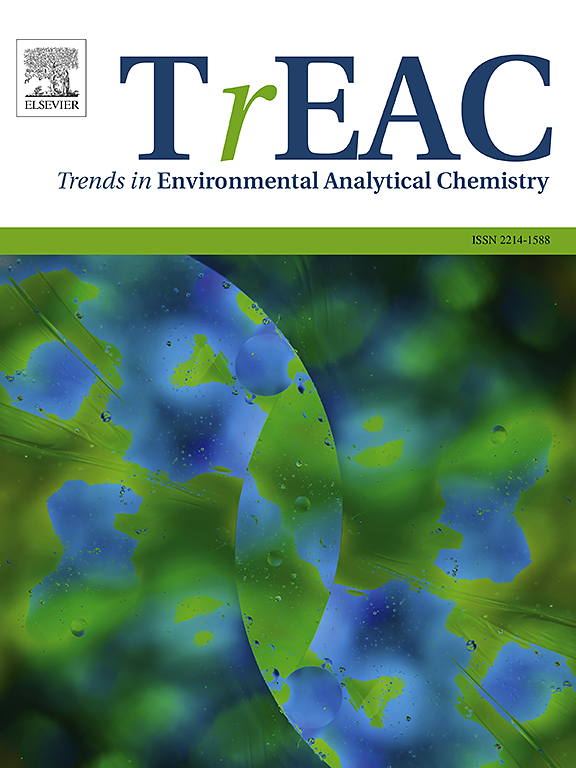Liquid chromatography-high resolution mass spectrometry methods for the identification of antifungal azoles’ transformation products through suspect and non-target analysis
IF 13.4
2区 化学
Q1 CHEMISTRY, ANALYTICAL
引用次数: 0
Abstract
Azoles, known for their antifungal properties, are among the most produced and utilized chemical classes globally, categorized into imidazole ring and triazole ring molecules bearing various substituents. They are recognized as a significant group of environmental contaminants. Owing to their widespread presence, persistence, and potential toxicity to humans and the environment, several azole compounds have been incorporated into the 4th European Union Watch List, which has been in place since 2022, continuing to include azolic fungicides similarly to previous editions. Azoles can undergo metabolism by microorganisms or various chemical degradation processes, resulting in transformation products (TPs) that may possess altered chemical properties, increased toxicity, and higher persistence and concentrations. Consequently, the identification and structural elucidation of azoles’ TPs are critical, with liquid chromatography high-resolution mass spectrometry (HRMS) playing a key role.
Recent advancements in non-target and suspect screening methods, alongside improvements in LC-HRMS technology, have greatly enhanced the field of environmental analytical chemistry. These innovations enable the detection and identification of both known and unknown compounds in samples without the need to fully depend on chemical standards. This review focuses on recent advancements in LC-HRMS techniques, especially those utilizing suspect and non-target screening for analyzing and elucidating the structure of azoles’ TPs. It discusses analytical methodologies, data processing workflows, and reviews studies on TPs found in environmental matrices, as well as those investigating advanced oxidation processes and biodegradation of azoles.
液相色谱-高分辨率质谱法鉴定抗真菌唑类药物转化产物的怀疑和非目标分析
氮唑以其抗真菌特性而闻名,是全球生产和利用最多的化学类别之一,分为咪唑环和三唑环分子,具有各种取代基。它们被认为是一组重要的环境污染物。由于其广泛存在、持久性和对人类和环境的潜在毒性,一些唑类化合物已被纳入欧盟第四次观察清单,该清单自2022年起实施,与以前的版本类似,继续包括偶氮类杀菌剂。唑类化合物可以通过微生物或各种化学降解过程进行代谢,导致转化产物(TPs)可能具有改变的化学性质、增加的毒性、更高的持久性和浓度。因此,在液相色谱-高分辨率质谱法(HRMS)的作用下,对唑类化合物的TPs进行鉴定和结构解析至关重要。近年来,非目标和可疑筛选方法的进步,以及LC-HRMS技术的改进,极大地促进了环境分析化学领域的发展。这些创新使样品中已知和未知化合物的检测和鉴定无需完全依赖化学标准。本文综述了液相色谱- hrms技术的最新进展,特别是利用可疑和非靶点筛选来分析和阐明唑类药物的tp结构。它讨论了分析方法,数据处理工作流程,并回顾了在环境基质中发现的TPs的研究,以及那些研究高级氧化过程和氮的生物降解的研究。
本文章由计算机程序翻译,如有差异,请以英文原文为准。
求助全文
约1分钟内获得全文
求助全文
来源期刊

Trends in Environmental Analytical Chemistry
Chemistry-Analytical Chemistry
CiteScore
21.20
自引率
2.70%
发文量
34
审稿时长
44 days
期刊介绍:
Trends in Environmental Analytical Chemistry is an authoritative journal that focuses on the dynamic field of environmental analytical chemistry. It aims to deliver concise yet insightful overviews of the latest advancements in this field. By acquiring high-quality chemical data and effectively interpreting it, we can deepen our understanding of the environment. TrEAC is committed to keeping up with the fast-paced nature of environmental analytical chemistry by providing timely coverage of innovative analytical methods used in studying environmentally relevant substances and addressing related issues.
 求助内容:
求助内容: 应助结果提醒方式:
应助结果提醒方式:


